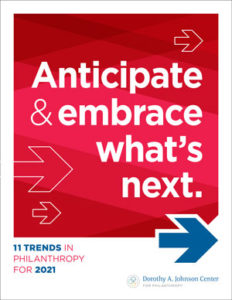Dynamic and Disruptive Forces are Increasingly at Work in Philanthropy


 At the Johnson Center, we think of philanthropy as an ecosystem of nonprofit organizations, individual donors, formal foundations of all types, and corporate giving programs. Essentially, it includes all of the nongovernmental entities who work toward improving our lives — that is, whose overall purpose is to express love of humanity.
At the Johnson Center, we think of philanthropy as an ecosystem of nonprofit organizations, individual donors, formal foundations of all types, and corporate giving programs. Essentially, it includes all of the nongovernmental entities who work toward improving our lives — that is, whose overall purpose is to express love of humanity.
The concept of an ecosystem comes from biology, where it is defined as a complex of living organisms, their physical environment, and their relationships in a particular unit of space. Increasingly, the word is being used to describe how organizations interact with each other and their environment. As Hwang (2014) noted,
An ecosystem … is about the dynamic interactions between things. It’s about how people meet, talk, trust, share, collaborate, team, experiment, and grow together. When an ecosystem thrives, it means that the people have developed patterns of behavior — or culture — that streamline the flow of ideas, talent, and capital throughout a system. (para. 11)
The concept of a nonprofit ecosystem got a boost from a 2008 article, “Cultivate Your Ecosystem,” in the Stanford Social Innovation Review by Paul N. Bloom and Gregory Dees. The authors argue that rather than finding gaps to fill, a social entrepreneur ought to understand where they fit as an entity within a larger, complex system.
“This trend of converging, overlapping, and nonlinear disruptions in the sector is likely to persist, elevating the demands on leaders to operate from an ecosystem perspective.”
In recent years, we’ve seen an increase in dynamic forces that are disrupting this philanthropic ecosystem. In previous years and in other trends we revisit in this report, we’ve described how some of these forces are affecting the sector. While complex systems are continually adapting to change, what has become apparent is that these trends are interacting in ways that were unforeseeable a decade ago. Some examples:
Even in their internal operations, lines are blurring. Over half of private foundations surveyed have part of their endowments in impact investments (Foundation Source, 2019), blurring the lines between business investments and philanthropy, investment manager and program officer.
This trend of converging, overlapping, and nonlinear disruptions in the sector is likely to persist, elevating the demands on leaders to operate from an ecosystem perspective. It will require greater collaboration between and among the entities that comprise the philanthropic ecosystem in which they are embedded. It will require new ways of training and bringing new leaders into the sector, cultivating the ability to work across what have traditionally been sectoral and socio-economic boundaries.


Bloom, P. N., & Dees, J. G. (2008, Winter). Cultivate your ecosystem. Stanford Social Innovation Review. https://ssir.org/articles/entry/cultivate_your_ecosystem
Dorsey, C., Bradach, J., & Kim, P. (2020, May 4). Racial equity and philanthropy: Disparities in funding for leaders of color leave impact on the table. The Bridgespan Group and Echoing Green. https://www.bridgespan.org/bridgespan/Images/articles/racial-equity-and-philanthropy/racial-equity-and-philanthropy.pdf
Foundation Source. (2019, November). Survey: Impact investing and private foundations. https://foundationsource.com/resources/library/impact-investing-and-private-foundations
Ho, H. K. (2017, September 18). 8 ways people of color are tokenized in nonprofits. Medium. https://medium.com/the-nonprofit-revolution/8-ways-people-of-color-are-tokenized-in-nonprofits-32138d0860c1
Hwang, V. W. (2014, April 16). The next big business buzzword: Ecosystem? Forbes. https://www.forbes.com/sites/victorhwang/2014/04/16/the-next-big-business-buzzword-ecosystem
Rooney, P. M. (2019, December 4). Where have all the donors gone? The continued decline of the small donor and the growth of megadonors. Nonprofit Quarterly. https://nonprofitquarterly.org/where-have-all-the-donors-gone-the-continued-decline-of-the-small-donor-and-the-growth-of-megadonors